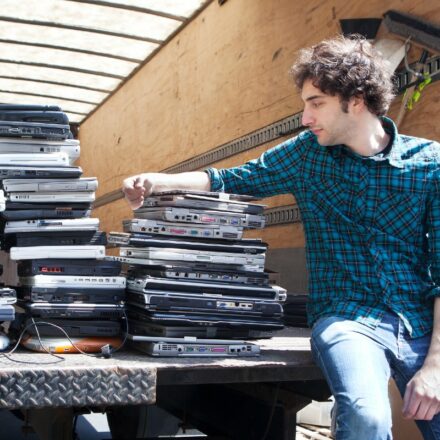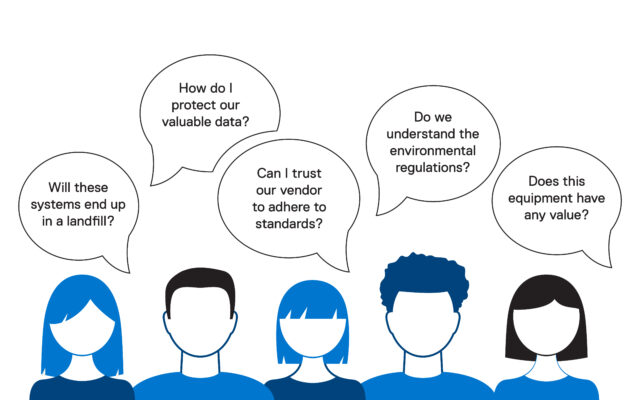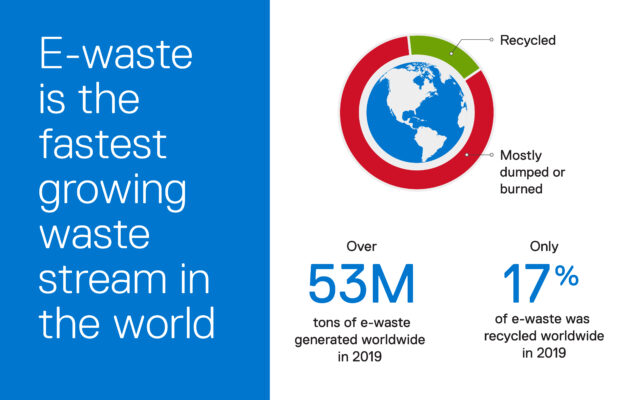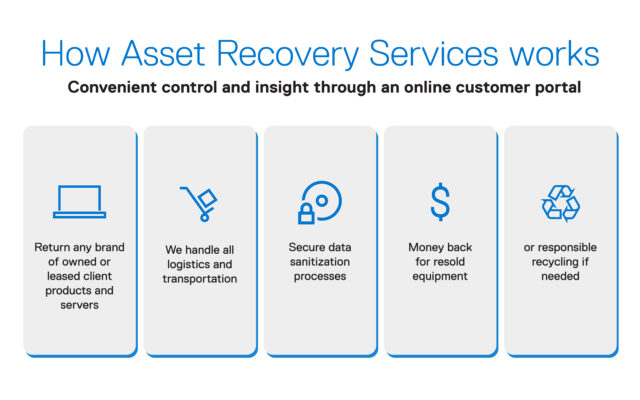As your company refreshes information technology to stay competitive and keep employees productive, you’re likely asking yourself lots of critical questions about your aging IT equipment, like:
At Dell Technologies, we understand your concerns. Disposing of IT equipment that’s reached its useful end of life can be challenging. In addition to wrestling with complex logistics and IT lifecycle issues, navigating the risks associated with data security and environmental liability can be headache. At times, it may feel easier to let aging equipment continue to depreciate on employee desks or to stash unused tech gear in storage, “out of sight, out of mind,” taking up valuable space.
Fortunately, there’s a simple, hassle-free and responsible approach to IT asset disposition.
Retire now versus later to maximize value for your business and the planet
Dell’s Asset Recovery Services can help your company responsibly retire IT equipment, while keeping your company’s sensitive data safe. We leverage our longstanding IT security expertise, environmental compliance and commitment to sustainability to help you seamlessly transition from old to new technology while protecting your business and the planet.
By diverting electronic waste (e-waste) from landfills, Asset Recovery Services can help you transform unused, end-of-life tech equipment from something that gets discarded into a reusable or recyclable asset, extending the useful life of technology. Your aging assets may be more valuable than you realize. By retiring IT assets while they still retain maximum residual value, you can unlock value and reinvest in new innovation.
Think of it as a secure, sustainable approach to “out with the old, in with the new.”
Keeping your data safe is our number one priority
Data security concerns weigh heavily on the minds of IT managers who must deal with excess equipment while also protecting their company’s sensitive information and valuable intellectual property – making it the number one reason companies either delay asset disposition or require help with the process.
At Dell, our top priority is safeguarding your data while protecting the environment. Our standardized procedures, multiple checkpoints and meticulous documentation provide end-to-end protection of your sensitive information. We sanitize all devices in strict alignment with the NIST SP 800-88r1 standard for media sanitization. If devices cannot be fully sanitized, we destroy all types of drives to prevent unauthorized data recovery.
As an extra level of security, we offer onsite data sanitization services, ensuring that all IT equipment is completely sanitized before leaving your facility. This includes onsite hard-drive shredding in which data-bearing hard drives are physically destroyed in an environmentally responsible manner. All data sanitization details are reported through our online portal, giving you full transparency and peace of mind along the way.
Help create sustainable value
E-waste is the fastest growing domestic waste stream. According to the UN Global E-waste Monitor 2020, the world generated 53.6 million metric tons of e-waste in 2019. That’s equivalent in weight to all the commercial aircraft ever built and enough material to cover an area the size of Manhattan – each year. Worse yet, only 17.4 percent of that e-waste was recycled. E-waste not only poses health and environmental hazards, it’s also untapped value that businesses of all sizes, across all sectors, could return to the circular economy.
Many companies recognize the urgency of the e-waste crisis and take sustainability seriously by adopting circular IT strategies that extend product life cycles through efficient design, repair, reuse and recycling. When a product reaches its end of life, the materials can be recycled and reused, creating sustainable value within the circular economy. Embracing this vision reduces environmental impact while giving businesses opportunities to increase competitiveness, stimulate innovation and revenue, reduce OPEX and create jobs.
While some of your IT equipment may have reached end of life, chances are, it has a little more to give. Through Asset Recovery Services, we recycle assets with no value in compliance with global regulatory guidelines, helping you avoid potential negative publicity from improper disposal while ensuring recycled materials get a new life. We adhere to strict environmental disposition standards for maximum reuse. We prioritize reuse and thoroughly test returned equipment for functionality to promote reuse and minimize e-waste whenever possible. Together, we can take meaningful steps toward prioritizing reuse and diverting e-waste from landfills.
How Asset Recovery Services works
We will help you resell, recycle or return to lease any brand of owned or leased client hardware, no matter where it came from. Whether you are managing a central or remote workforce, there are no unit minimums. This applies to desktop PCs, laptops, servers, peripheral devices and accessories.
Leave the end-to-end logistics and transportation of returned equipment to us. We’ll handle every detail from pickup to final reporting, so you can stay focused on your core business. Again, we safeguard your data through secure data sanitization processes and offer on-site data sanitization options for added security.
The process starts by scheduling a quick appraisal to help you determine what your equipment is worth so you can cash in to help your business grow. Then we resell the sanitized equipment and return the value to you, or we responsibly recycle assets that cannot be reused or have no residual value.
You can efficiently manage the entire asset recovery process through our centralized online portal, available through TechDirect. For peace of mind, the portal gives you real-time access to detailed status reports. Device appraisals, order tracking, data sanitization, disposal confirmation, recycling details and other on-demand reports are at your fingertips. When it’s all done, use the portal to track payments and transfer funds electronically. It’s that simple.
Dell: Your asset recovery partner
Dell has provided secure asset recovery services for businesses worldwide for more than 25 years. Since 2008, we have recovered more than 2.5 billion pounds of used electronics, and we’re not stopping there. We have the scope, scale and compliance expertise to manage the entire asset disposition process from end to end, shielding you from multi-vendor headaches. We take protecting your data, your brand reputation and the environment very seriously and require the same from our partner organizations.
Sustainability and product stewardship are at the heart of everything Dell does. By 2030, we aim to achieve these goals:
-
- For every product a customer buys, we plan to reuse or recycle an equivalent product.
- 100 percent of our packaging will be made from recycled or renewable materials.
- More than half of our product content will be made from recycled or renewable materials.
By leveraging Dell’s security expertise and commitment to sustainability, you can responsibly resell, recycle or return to lease your legacy IT equipment and shift your focus to what’s next and best for your business.
To learn more, please visit our Asset Recovery Services page.





